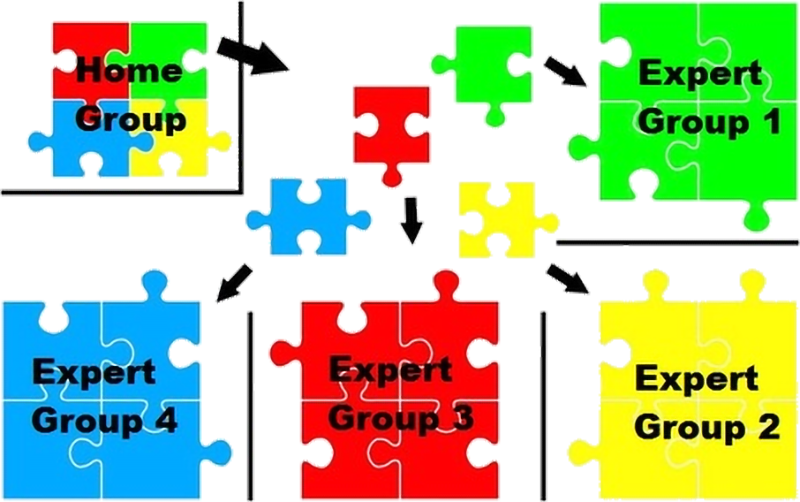Organisation of Training
The overall organization of the training is a modified version of the Jigsaw Classroom. This page explains in more detail how the training component of the project has been organized.
The Jigsaw Classroom
In the basic Jigsaw Classroom, students participate in two groups: The Jigsaw Group or the Home Group (HG) and the Expert Group (EG). The HG has a joint assignment to solve that contains as many chunks of knowledge as there are students in the group (normally between 4 and 6) and each student in the HG is assigned only one chunk of knowledge that (s)he must bring to the group. In order to acquire this chunk of knowledge, each student participates in an EG where all those students who have to acquire the same chunk of knowledge are gathered and learn about and discuss their particular chunk of knowledge. After the EG work, the students return to their HG to teach their peers in the HG, through a peer teaching/peer learning session, based on the knowledge they have acquired. The picture below is an attempt to illustrate this process.

The EEISHEA Training approach
In the EEISHEA project, the Home Groups are the five African Local Task Force (LTF) teams who have to jointly redesign a chosen curriculum, integrating in the curriculum contents relevant elements of Entrepreneurship & Innovation (E&I) and Sustainability (SUS), while delivering the redesigned curriculum through the use of relevant Student-Centred Learning (SCL) approaches and applying relevant E-Learning (E-L) tools. The Expert Groups are the four Training Teams, consisting of three EU trainers and two persons from each African university. After being trained in the two EU f2f workshops, the two trainees return to their university where they in the Third f2f training workshop teach their colleagues in the LTF on the newly acquired expert knowledge, thus drawing on peer teaching and peer learning.
The main modifications to the basic Jigsaw Classroom are the following:
- Two trainees from each home group in each training team, instead of one, thus making the scheme more robust and providing for better transfer of knowledge from trainees-turned-experts to other project group members
- Two facilitated F2F workshops in EU institutions instead of one session, to give a broader and more diverse exposure to the training area
- Blended learning instead of only direct F2F interaction, to allow for ongoing discussions
Perspectives
The perspective in using this modified Jigsaw Classroom technique in the project is that the teachers within the African universities can use the same technique to organize student-centred learning in their own classrooms. Thus, organization of learning in the project is exemplary for its own contents.